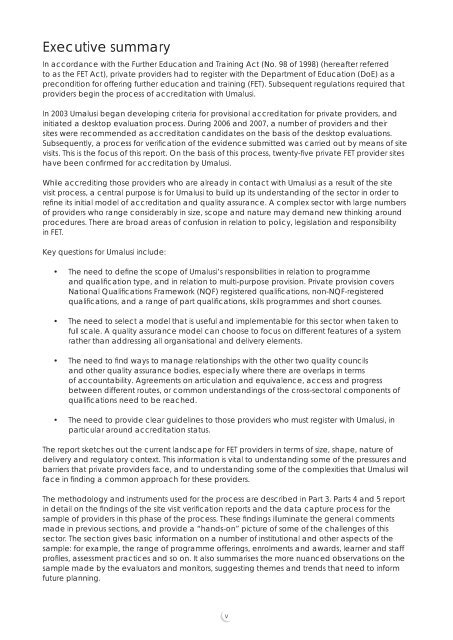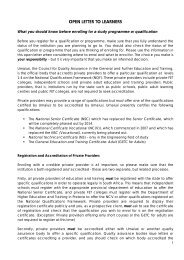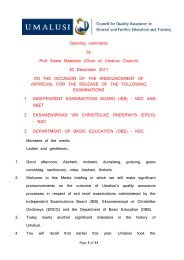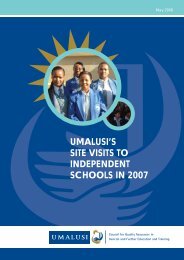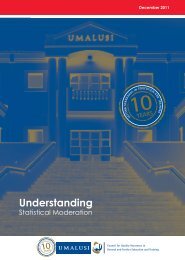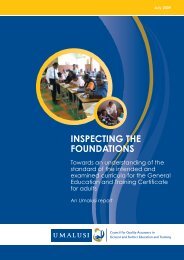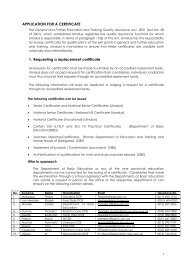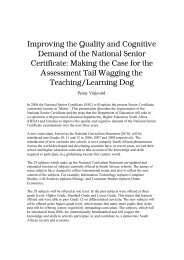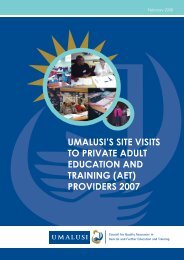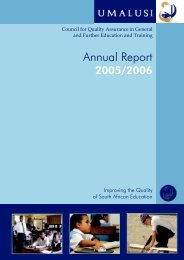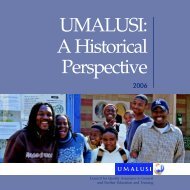fet private providers site visit and verification report - Umalusi
fet private providers site visit and verification report - Umalusi
fet private providers site visit and verification report - Umalusi
You also want an ePaper? Increase the reach of your titles
YUMPU automatically turns print PDFs into web optimized ePapers that Google loves.
Executive summaryIn accordance with the Further Education <strong>and</strong> Training Act (No. 98 of 1998) (hereafter referredto as the FET Act), <strong>private</strong> <strong>providers</strong> had to register with the Department of Education (DoE) as aprecondition for offering further education <strong>and</strong> training (FET). Subsequent regulations required that<strong>providers</strong> begin the process of accreditation with <strong>Umalusi</strong>.In 2003 <strong>Umalusi</strong> began developing criteria for provisional accreditation for <strong>private</strong> <strong>providers</strong>, <strong>and</strong>initiated a desktop evaluation process. During 2006 <strong>and</strong> 2007, a number of <strong>providers</strong> <strong>and</strong> their<strong>site</strong>s were recommended as accreditation c<strong>and</strong>idates on the basis of the desktop evaluations.Subsequently, a process for verifi cation of the evidence submitted was carried out by means of <strong>site</strong><strong>visit</strong>s. This is the focus of this <strong>report</strong>. On the basis of this process, twenty-fi ve <strong>private</strong> FET provider <strong>site</strong>shave been confi rmed for accreditation by <strong>Umalusi</strong>.While accrediting those <strong>providers</strong> who are already in contact with <strong>Umalusi</strong> as a result of the <strong>site</strong><strong>visit</strong> process, a central purpose is for <strong>Umalusi</strong> to build up its underst<strong>and</strong>ing of the sector in order torefi ne its initial model of accreditation <strong>and</strong> quality assurance. A complex sector with large numbersof <strong>providers</strong> who range considerably in size, scope <strong>and</strong> nature may dem<strong>and</strong> new thinking aroundprocedures. There are broad areas of confusion in relation to policy, legislation <strong>and</strong> responsibilityin FET.Key questions for <strong>Umalusi</strong> include:• The need to defi ne the scope of <strong>Umalusi</strong>’s responsibilities in relation to programme<strong>and</strong> qualifi cation type, <strong>and</strong> in relation to multi-purpose provision. Private provision coversNational Qualifi cations Framework (NQF) registered qualifi cations, non-NQF-registeredqualifi cations, <strong>and</strong> a range of part qualifi cations, skills programmes <strong>and</strong> short courses.• The need to select a model that is useful <strong>and</strong> implementable for this sector when taken tofull scale. A quality assurance model can choose to focus on different features of a systemrather than addressing all organisational <strong>and</strong> delivery elements.• The need to fi nd ways to manage relationships with the other two quality councils<strong>and</strong> other quality assurance bodies, especially where there are overlaps in termsof accountability. Agreements on articulation <strong>and</strong> equivalence, access <strong>and</strong> progressbetween different routes, or common underst<strong>and</strong>ings of the cross-sectoral components ofqualifi cations need to be reached.• The need to provide clear guidelines to those <strong>providers</strong> who must register with <strong>Umalusi</strong>, inparticular around accreditation status.The <strong>report</strong> sketches out the current l<strong>and</strong>scape for FET <strong>providers</strong> in terms of size, shape, nature ofdelivery <strong>and</strong> regulatory context. This information is vital to underst<strong>and</strong>ing some of the pressures <strong>and</strong>barriers that <strong>private</strong> <strong>providers</strong> face, <strong>and</strong> to underst<strong>and</strong>ing some of the complexities that <strong>Umalusi</strong> willface in fi nding a common approach for these <strong>providers</strong>.The methodology <strong>and</strong> instruments used for the process are described in Part 3. Parts 4 <strong>and</strong> 5 <strong>report</strong>in detail on the fi ndings of the <strong>site</strong> <strong>visit</strong> verifi cation <strong>report</strong>s <strong>and</strong> the data capture process for thesample of <strong>providers</strong> in this phase of the process. These fi ndings illuminate the general commentsmade in previous sections, <strong>and</strong> provide a “h<strong>and</strong>s-on” picture of some of the challenges of thissector. The section gives basic information on a number of institutional <strong>and</strong> other aspects of thesample: for example, the range of programme offerings, enrolments <strong>and</strong> awards, learner <strong>and</strong> staffprofi les, assessment practices <strong>and</strong> so on. It also summarises the more nuanced observations on thesample made by the evaluators <strong>and</strong> monitors, suggesting themes <strong>and</strong> trends that need to informfuture planning.v


